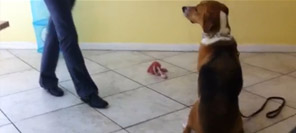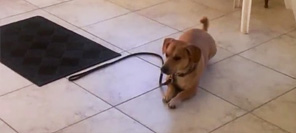I’ve trained thousands of Tampa Bay dog owners and their puppies. Handler enthusiasm sometimes translates into the exuberant repetition of verbal commands, stemming from a natural desire to succeed and follow through.
One, not so obvious, piece of training advice I find myself giving to owners regularly is to “skip a beat” during obedience training. In other words… take a breath, refocus, don’t panic, get your dog’s attention and then try the command again. Some trainers may tell you to never re- issue a command and to always correct at the time of refusal. This can be unfair to your dog if you are a new handler and do not have an established training vocabulary with your dog yet. I find that there is just as much power in a few seconds of silence after you give a command. Allow your dog the chance to work it out then reward for progressive compliance.
If your dog has been through my training program then he or she knows what “no” and “yes” mean, having used these as verbal markers throughout the training. The word “no” before the re- issuance of a command is a great way to reset and get your dog’s attention before trying the command again. Even if you haven’t been through my program, chances are still good that your dog has heard “no” before ( am I right? ) and understands that he or she should keep trying to get it right.
When working with your dog, keep in mind that engagement is the key to successful training. To help your dog engage with you while working on commands you should speak clearly, with encouragement and enunciation ( commands are not corrections and shouldn’t sound like they are). Never rush your commands…”sit, sit, sit, sit, SIT” ( with panic and dread in your voice)! Instead, say them once clearly, emphatically and confidently. Wait a few seconds for your dog to acknowledge you. Get his or her attention if he or she is distracted or has refused a command then say “no”, wait another second while your dog watches you in anticipation, and then re-issue your command clearly. Always follow up with praise or reward immediately upon success. Use treats with discrimination and only for progress such as faster responses or better form. Always be building on your last success.
If you can remember to skip a beat while working with your dog you will have much greater engagement and reliability with basic commands.
The above advice is intended to help with issues of compliance and engagement when working on commands for which your dog has already learned the basic meaning .
See this article on using markers during dog training:
Good Luck!
Tripp’s Dog Training Tampa-
Sarah





